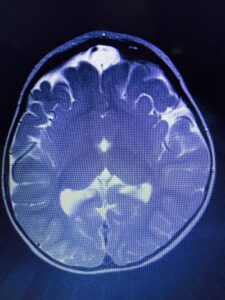
When I first heard the word Holoprosencephaly I was on the phone to a consultant who was explaining to me that the initial concern they had about the absence of some brain structures was in fact, far worse than they had thought and my baby had a condition called Semi-lobar Holoprosencephly.
We were told that there wasn’t a specific support group or any kind of official information. The only thing we were given was the diagnosis and a very bleak prognosis and then it was down to us to do our own research. This is what we now know.
What is Holoprosencephaly?
It is a congential cephalic disorder. Which in non-medical language means that it is abnormal development of the brain which happens before birth.
The following description is from the Families for HoPE website:
Ho•lo•pros•en•ceph•a•ly is a congenital brain disorder caused by a failure of an embryo’s forebrain to divide to form bilateral cerebral hemispheres (the left and right halves of the brain), causing defects in the development of the face and in brain structure and function.
According to the Carter Centers for Brain Research in Holoprosencephaly and Related Malformations, “It is estimated that HPE affects between 1 in 5,000-10,000 live births. Since many pregnancies with a fetus diagnosed with HPE end in miscarriage, the frequency of HPE among all pregnancies may be as high as 1 in 200-250. Current studies indicate that only 3% of all fetuses with HPE survive to delivery and the vast majority of these infants do not survive past the first six months of life.”
HPE is a condition without a cure or a standard course of treatment. Treatment for HPE is symptomatic and supportive. Individuals with HPE can also have secondary conditions such as mental retardation, epilepsy, diabetes insipidus, pituitary and hormone disorders, movement disorders, gastroesophageal reflux, respiratory disorders, and hydrocephalus.
And the Semi-lobar bit?
HPE is divided into four types depending on severity. It is important to note that structural severity does not necessarily equate to symptomatic severity. Each case is individual.
Again taken from the Families for Hope website:
(1) Alobar (severe) – where the brain is not divided and there are severe abnormalities.
(2) Semi-Lobar (moderate) – where the brain is partially divided and there are some moderate abnormalities; where there are two hemispheres in the rear but not the front of the brain.
(3) Lobar (mild) – where the brain is divided and there are some mild abnormalities.
(3a) Lobar Subtype: Septopreoptic HPE (very mild) – only a small area of the brain is fused and the abnormalities are very mild; children with this subtype usually have good motor function.
(4) Middle Interhemispheric Variant (MIHV) – where the middle of the brain (posterior frontal and parietal lobes) are not well separated.
For more information on Holoprosencephaly visit the full Families for Hope site here: Families for HoPE
Also find support through Facebook by joining Families for Hope or the Holoprosencephaly UK group
